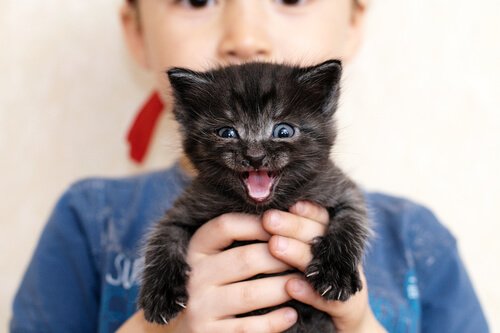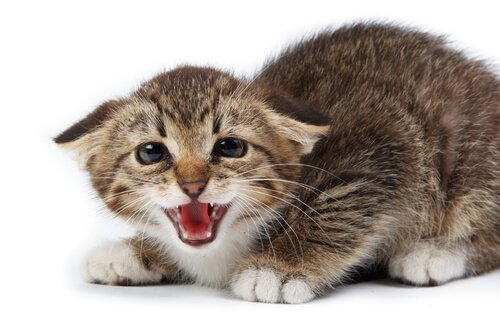Why Do Cats Purr?


Written and verified by the lawyer Francisco María García
A cat’s purr is a sound that’s emitted rhythmically at a low volume. Usually, people associate this noise with pleasure or relaxation, like when a cat is enjoying being petted. However, domestic cats can routinely emit these sounds in different situations. Below, you can find out why cats purr, and what these feline sounds mean.
Cats and their extraordinary ability to vocalize
Everyone knows that cats have an incredible ability to vocalize, other than just meowing and purring. Cats are able to make more than 100 different sounds in different situations.
Although cats mostly use body language to communicate, these vocalizations fulfill important roles in their relationships with humans, other cats, and their environment. Among the many possible vocalizations, 11 sounds stand out as the most common ones that cats routinely use. They are the following:
- Meowing
- Purring
- Chirping
- Hissing
- Mating calls
- Growling
- Squealing
- Distress call
- Howls and shrieks
- Murmurs
- “Clucking“
What do cat purrs mean?
Many owners wonder why cats purr in different moments. Before answering this question, it’s important to understand that each cat is an individual and has a unique personality. Therefore, it’s impossible to come up with a manual on how to understand a cat’s purrs and meows.

To interpret what your cat means when it purrs, you must consider the context of the vocalization. It’s essential to analyze the cat’s posture and facial expressions to identify their mood and understand the message they’re trying to get across.
Below are the main reasons why cats purr to help you improve your communication with your cat. Remember to set aside a special time to spend with your cat, to analyze their body language and get to know their unique personality.
Why do cats purr when they’re petted?
In domestic and wild felines, purring is characterized as a very positive sound. It indicates emotions like complacency, desire, or serenity. At home, you can see that a cat purrs in several situations that give them pleasure, such as eating, receiving their favorite toy, or being petted by a family member.
When a cat purrs when they’re petted, this sound is usually smooth and irregular. This is a sign that your cat is in a state of pure relaxation and complacency.
Purring also indicates that your cat feels safe in your company, and they both of you share a bond based on mutual trust and love.
In other occasions, cats can also purr to get your attention and ask you for something they want. This purr is different from the previous one because it’s persistent and has a regular, intense tone. It’s a sign of how stubborn your cat can be in order to get what they want.

Why do kittens purr?
During birth, you can see that mother cats purr in a serene, regular fashion. They do this to create a calm environment and to calm her young during their first contact with the outside world.
The mother’s purr also guides kittens during their first days of life, when they still can’t orient themselves by their own senses.
Thus, kittens also purr when they drink breast milk, as a sign of pleasure and calmness. Plus, these little ones use purring to ask their parents for help, when faced with any threat or strange stimulus.
When purring is a cause for concern
Although it’s not as common as purring out of pleasure, cats can purr as a sign of pain or discomfort. In such cases, it will be higher and noisier, because they seek to get their owner’s attention for immediate help.
If your cat purrs very loudly and shows other signs of pain or changes in their behavior, you must take them to the vet immediately because something may be wrong.
On the other hand, purring is also a way for the cat to ask you to get rid of an annoying or uncomfortable situation. This sound of appeasement is emitted evenly and frequently. In this way, the feline expresses its friendship and shows that it doesn’t want to enter into any conflict.
A cat’s purr is a sound that’s emitted rhythmically at a low volume. Usually, people associate this noise with pleasure or relaxation, like when a cat is enjoying being petted. However, domestic cats can routinely emit these sounds in different situations. Below, you can find out why cats purr, and what these feline sounds mean.
Cats and their extraordinary ability to vocalize
Everyone knows that cats have an incredible ability to vocalize, other than just meowing and purring. Cats are able to make more than 100 different sounds in different situations.
Although cats mostly use body language to communicate, these vocalizations fulfill important roles in their relationships with humans, other cats, and their environment. Among the many possible vocalizations, 11 sounds stand out as the most common ones that cats routinely use. They are the following:
- Meowing
- Purring
- Chirping
- Hissing
- Mating calls
- Growling
- Squealing
- Distress call
- Howls and shrieks
- Murmurs
- “Clucking“
What do cat purrs mean?
Many owners wonder why cats purr in different moments. Before answering this question, it’s important to understand that each cat is an individual and has a unique personality. Therefore, it’s impossible to come up with a manual on how to understand a cat’s purrs and meows.

To interpret what your cat means when it purrs, you must consider the context of the vocalization. It’s essential to analyze the cat’s posture and facial expressions to identify their mood and understand the message they’re trying to get across.
Below are the main reasons why cats purr to help you improve your communication with your cat. Remember to set aside a special time to spend with your cat, to analyze their body language and get to know their unique personality.
Why do cats purr when they’re petted?
In domestic and wild felines, purring is characterized as a very positive sound. It indicates emotions like complacency, desire, or serenity. At home, you can see that a cat purrs in several situations that give them pleasure, such as eating, receiving their favorite toy, or being petted by a family member.
When a cat purrs when they’re petted, this sound is usually smooth and irregular. This is a sign that your cat is in a state of pure relaxation and complacency.
Purring also indicates that your cat feels safe in your company, and they both of you share a bond based on mutual trust and love.
In other occasions, cats can also purr to get your attention and ask you for something they want. This purr is different from the previous one because it’s persistent and has a regular, intense tone. It’s a sign of how stubborn your cat can be in order to get what they want.

Why do kittens purr?
During birth, you can see that mother cats purr in a serene, regular fashion. They do this to create a calm environment and to calm her young during their first contact with the outside world.
The mother’s purr also guides kittens during their first days of life, when they still can’t orient themselves by their own senses.
Thus, kittens also purr when they drink breast milk, as a sign of pleasure and calmness. Plus, these little ones use purring to ask their parents for help, when faced with any threat or strange stimulus.
When purring is a cause for concern
Although it’s not as common as purring out of pleasure, cats can purr as a sign of pain or discomfort. In such cases, it will be higher and noisier, because they seek to get their owner’s attention for immediate help.
If your cat purrs very loudly and shows other signs of pain or changes in their behavior, you must take them to the vet immediately because something may be wrong.
On the other hand, purring is also a way for the cat to ask you to get rid of an annoying or uncomfortable situation. This sound of appeasement is emitted evenly and frequently. In this way, the feline expresses its friendship and shows that it doesn’t want to enter into any conflict.
This text is provided for informational purposes only and does not replace consultation with a professional. If in doubt, consult your specialist.








